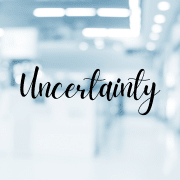 Do you struggle to cope with the amount of change you experience around? Is change a constant at work?
Do you struggle to cope with the amount of change you experience around? Is change a constant at work?
Change is a fundamental fact of life. You cannot stop the onward march of change, but you can manage how you react to it. There are things you can do to cope with it personally and plenty you can do as a business owner or manager to support people and help the transition.
It is inevitable, change, but you can actually deal with it, and you can actually develop some coping strategies. You can also do some key things to make it less scary.
Dealing with Change on a Practical Level
On a daily basis within the businesses, change can be anything. When we think about change, we think more about the major change, such as restructuring, people buying over businesses, people losing their jobs but there is minor change as well. For example: going on a training course has an impact in terms of the where and when you’re going to be doing your work. This means you also have to think about change within the work space.
What about change in our personal life and what impact does it have on our daily activities within the work space?
We need to look at at change holistically and not compartmentalise it in terms of work and personal life.
We spend much of our time at work and change here has a major impact, but is change necessary? Businesses have to change to keep up. We need to juggle changes in technology, requirements of different generations of staff, differing client requirements and staying ahead of the game to stay in business.
The impact of change on the employee wellbeing
Change, for most people, tends to be quite an uncomfortable place to be. It means that there is uncertainty. It could be that there job might change or disappear altogether for example. Employees are likely to be worried about the new role, whether they’ve got the right capabilities in place to be able to deal with it.
Somebody might be worried about whether they’re actually going to have a role with the changes that are coming – there will be a level of uncertainty about what’s going to happen – “am I going to have a job in the future”.
Even if you’re working for yourself there’s still a massive level of uncertainty around change. You’re constantly on the lookout regarding your client base, what’s going to happen tomorrow and I’m going to have enough money to pay the mortgage. You know when you’re working for yourself you tend to get those peaks and troughs so actually responding to all those demands is what makes things worrying.
It doesn’t just impact employees but it impacts sole traders and business people as well.
Are our leaders resilient enough to manage change?
Communication, communication, communication is key. It doesn’t have to be a complicated strategy that you’re putting in place. It can be something simple, but tell employees why change is happening. Explain to them the impact it’s going to have on them. Much of the worry will be because employees do not feel informed or included. Make sure to get their input too. They might think of something you have not. We think we need to come up with the solutions ourselves but often your employees have the answer.
Giving employees the opportunity to ask questions and including them as part of the process helps reduce the stress. Communication is very important.
Communicating with customers or clients is equally important. It might be that their needs are driving the change too. Keep them in the loop and work with them to deliver fit for purpose solutions.
As a small business owner it can be quite isolating and change can feel that much more stressful. You need support around yourself. You need to think about where can you get that support. Reach out to others and get their input.
If you’re working within a co space environment there will be other people that are sole traders as well or start-ups. See if you can get a network group going within that environment and how you can help each other.
A coach can also be a great benefit to help manage change. They are a great sounding board, listener and trusted advisor.
Mindset
Many people worry about what the outcomes might be, and have a tendency to catastrophizing and in their minds that things will be a lot worse than they are. You have to find people around you that you can go and talk to, to actually talk about your fears and worries, and to go through a process that they can help you with, where you are given the space to think about what the worst-case scenario will be.
- Is that really likely to happen?
- Have I been in this situation before?
- Was it as bad as we expected?
Going through this process will help put it into perspective, and nine times out of 10 things are never as bad as you think. Even if it is worst case scenario, and you are working for a company and is facing redundancy; you never know what sort of opportunities are going to come along.
Mindset and how you approach things, looking for the positive can make a massive difference about how you feel internally. Try reframing any negative thoughts and see how you can make it into a positive one.
Find techniques that help you destress, make sure you take time for yourself and do something fun.
For further ideas go to https://www.facebook.com/ProsperThroughPeople/ where you will find a growing number of videos to help you.
It is very easy to keep pushing, which can lead to burn out so self-care and care of your employees is really important.
Making change personal
If you want to make changes on a personal level, one of the key things is to really understand where you’re at. So for any change to happen, you really need to know where your starting point is.
Journaling is really useful to actually be able to look internally and see where you are at and what your mindset is. So start to do things like, say for example, if you find a particular situation stressful, start to make a really short journal. It doesn’t have to be pen and paper we’ve all got smartphones these days, it’s really easy to get an app to do journaling on. It doesn’t matter where you do it you can also record messages there’s apps like mental snap where you can record your mental state.
The important thing is to actually have that inward reflection and start to look at; okay I’ve got a bit anxious about that. What was the trigger? And then start to look at, what was it something external, was it something that I didn’t understand, was it that I didn’t have enough information, was it me reacting to it to somebody else, and just really understand what the triggers are and what makes you feel that the worst is going to happen in the first place.
Once you’ve done that journaling, you’ll start to understand and dig under your own hood a little bit as to what makes you tick, and what actually puts you into that, we like to call it sort of catastrophizing, where you always think the worst is going to happen. And then you can start taking steps to think about well actually is that really, really the case.
Mahatma Gandhi said: “Be the change you want to see in the world.”
Change is a journey. I hope you enjoy your journey.
Written by Alison Charles and Reyhana Jano











